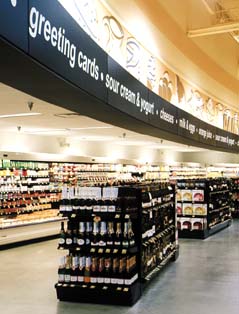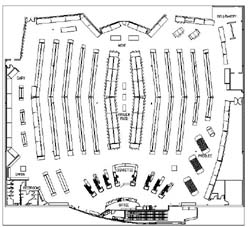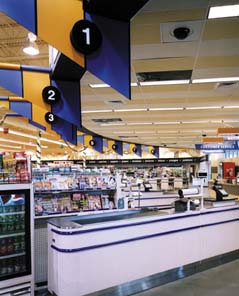The round walls and perimeter aisle pattern were designed to give the new Food Lion supermarket prototype a sense of speed and motion.
In Concord, N.C., where the first version was installed, speed and motion are part of the local culture. The store is located about two miles from the Lowe's Motor Speedway and has a Dale Earnhardt Boulevard running nearby.
But the sense of motion had another objective: to give shoppers everywhere the impression that their shopping experience would be speedy and efficient. In a retail sector increasingly pushed by the 200,000-square-foot hypermarkets, Food Lion wanted to position its 38,000-square-foot store as a quick, easier-to-shop alternative.
Food Lion LLC (Salisbury, N.C.) – a subsidiary of Delhaize America, the U.S. division of international retailer Delhaize Group (Brussels) – tapped ArchitecturePlus Intl. (API, Tampa, Fla.), and together they raised the ceiling, changed the aisle patterns and rounded out the corners for the Concord prototype.
Kyle Mitchell, Food Lion's vp, construction and engineering, knew that the feel of speed would gain a lot of mileage in NASCAR-crazy North Carolina. But Mitchell and his team were more interested in the race that takes shoppers from the parking lot into the exterior-striped store; through the store, past bold, rich, colorful wayfinding graphics and along an unorthodox aisle plan; and out the store, in a semicircular approach to cashwraps that decongests the front end and leaves shoppers with a memory of convenient, efficient supermarket shopping.
And just as NASCAR is always experimenting with new and better track surfaces, Food Lion sought to revolutionize its shopping experience by experimenting with a poured concrete floor.
Advertisement
The interior aisles are not parallel, as is usually the case, but bent in a chevron configuration. Mitchell notes that shoppers standing at the end of an aisle can see 75 percent of the merchandise, whereas those same shoppers might see only 25 percent of the products on shelves elsewhere. A 7-degree bend in the middle of each aisle puts the shelves at an angle conducive for viewing products from a distance, for what Mitchell calls “a billboard of products.” The bend also helps shoppers in the frozen-food aisles see the merchandise behind the glass doors rather than simply the glare from the overhead lights.
“This is more open than our traditional store,” Mitchell says. “There isn't a square corner inside, the open industrial ceilings are 25 feet high and stripes on aisle markers and bands of color around interior walls give the sense of speed, ease and efficiency. Products are more visible, and the lighting system – both in the heart of the store and around the perimeter – acts to move shoppers around and through the space.”
Long associated as a low-cost provider, Food Lion also wanted to upgrade its image for quality and selection. “We wanted to use architecture to send the message of variety within the store,” Mitchell says. “And we wanted to provide an environment that was at once modern and at the same time softer, warmer, calming, inviting.”
“Food Lion always stood for low price, but low price has become the basic ticket of admission in the grocery business,” says API president Juan Romero. “The key today is to evolve the brand, find that positive attribute other than low price.”
The three brand attributes this store tries to deliver are convenience, assortment and ease of shopping. The “ease of shopping” message has been intensified by the design of the check-out area, where the lanes fan out to make carts easier to manipulate and unload, making the whole area seem more wide-open and giving the shopper the feeling she's in control.
An upgraded lighting system also helps facilitate the feel of the store. High-bay metal halide fixtures dropped from the ceiling direct clear, high-color-definition lighting onto the produce tables and baked goods and around the perimeter of the store. Fluorescent strips with both down- and up-lighting bathe the butter-colored ceiling in the interior sections of the store with a golden glow to give the space a warm, incandescent aura.
Advertisement
The poured concrete floor, another departure from the traditional supermarket, is based on functionality as well as design. “Traditional vinyl-composition tile (VCT) is the most expensive flooring to maintain,” says Tom Henken, API vp, director of design. “There's a constant need to apply and reapply the necessary layer of wax. The concrete, however, is treated with a topical golden tint that hardens the first three-eighths of an inch. But it also absorbs wetness so that there are fewer slip falls. In the long run, that will reduce the retailer's legal fees.”
Client: Food Lion LLC, Salisbury, N.C. – Kyle Mitchell, vp, construction and engineering; Keith Gehl, executive vp/business strategy
Design: ArchitecturePlus Intl., Tampa, Fla. – Juan Romero, president; Tom Henken, vp/director of design; Judy Norlin, interiors; Ryan Martin, Geoff Stone, graphics
Suppliers: Muzak LLC, Charlotte, N.C. (audio/visual); Lozier, Omaha, Neb. (fixtures); Amerlux Lighting Solutions, Fairfield, N.J. (lighting); Hobart Corp., Troy, Ohio (deli equipment); Floratech, N. Syracuse, N.Y. (floral cases)


 Photo Gallery2 days ago
Photo Gallery2 days ago
 Headlines1 week ago
Headlines1 week ago
 Headlines2 weeks ago
Headlines2 weeks ago
 Sector Spotlight2 weeks ago
Sector Spotlight2 weeks ago
 Headlines1 week ago
Headlines1 week ago
 Headlines3 days ago
Headlines3 days ago
 Headlines1 week ago
Headlines1 week ago
 Designer Dozen1 week ago
Designer Dozen1 week ago



















